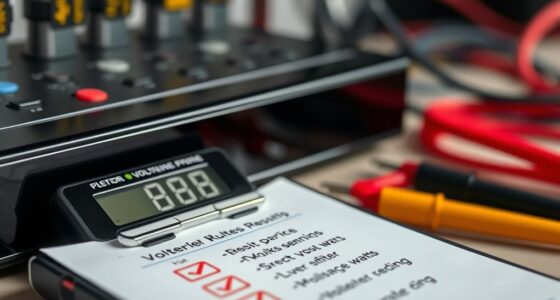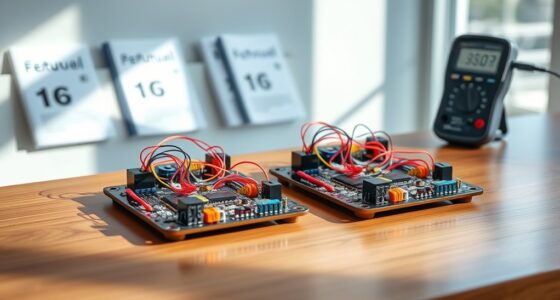Understanding surge versus running watts helps you choose the right power source and safeguard your devices. Surge watts are the initial power needed to start appliances, often higher than the steady running watts required to keep them going. Knowing both ensures you don’t overload your generator or cause damage. Getting familiar with these differences makes you more confident in selecting the proper equipment, and a closer look at more details will help you master the essentials.
Key Takeaways
- Surge watts are the initial power needed to start appliances with motors or compressors.
- Running watts refer to the steady power appliances consume during normal operation.
- Knowing both helps prevent overloads and select the right generator or power source.
- Always check device labels for surge and running wattage ratings to ensure proper matching.
- Adding a safety margin to total wattage requirements enhances reliability and protects equipment.
Understanding Power Basics: Watts, Surge, and Running

Have you ever wondered what those numbers on your electrical devices really mean? Understanding power basics, like watts, surge, and running power, helps you make smarter choices. Watts measure the amount of power your device consumes or produces, directly affecting voltage stability and overall performance. Surge watts indicate the initial power needed to start a device, often higher than its running watts, which sustain operation. Recognizing these numbers allows you to ensure your equipment operates efficiently, avoiding overloads that can harm devices or cause power fluctuations. Better understanding of these concepts improves power efficiency, reducing waste and saving energy. When selecting appliances or generators, knowing the difference between surge and running watts helps you match your power needs precisely, ensuring smooth, reliable operation without risking voltage dips or surges. Additionally, understanding the importance of power ratings helps you choose the right equipment and prevent potential damage caused by mismatched power requirements.
What Are Surge Watts and Why Do They Matter?

Ever wonder why some appliances require a burst of extra power when they start up? That’s where surge watts come into play. Surge watts measure the initial power demand needed to get an appliance running, often higher than its normal operating wattage. This short burst is essential because many devices, like refrigerators or power tools, draw a surge of electricity when they first turn on. Understanding surge wattage is key for proper surge protection, ensuring your generator or power source can handle these spikes without tripping or damage. Wattage measurement helps you match your equipment with the right power supply, preventing overloads. By knowing surge watts, you can choose the right generator, keep your appliances safe, and avoid unexpected power interruptions. Additionally, being aware of lifestyle factors such as remote work setups can influence your power needs and the importance of reliable power sources.
The Significance of Running Watts in Daily Use
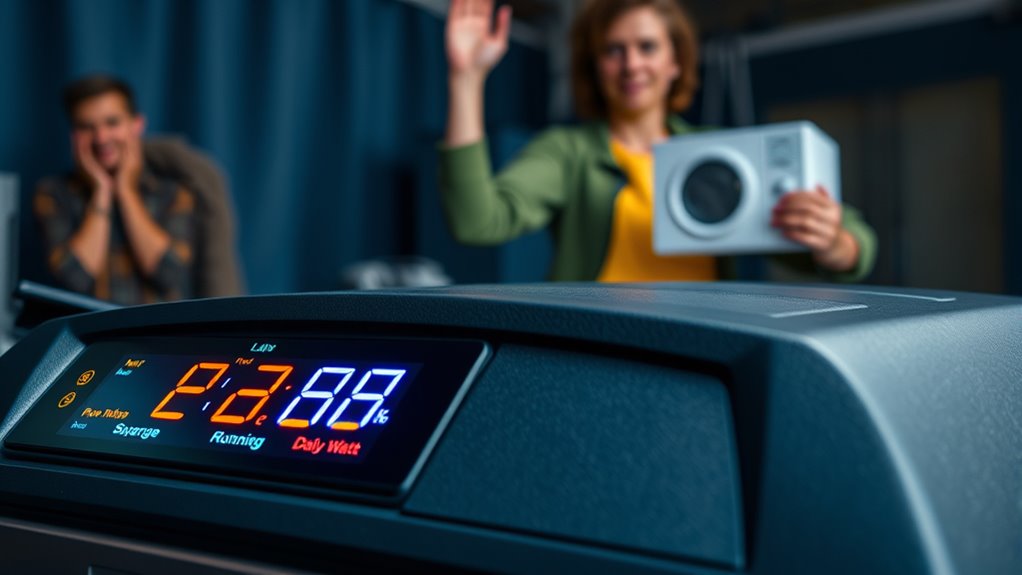
Understanding the importance of running watts is essential because they represent the consistent power your appliances need to operate smoothly during everyday use. Knowing your appliances’ running wattage helps you choose the right generator, guaranteeing reliable performance without overloads. Regular generator maintenance keeps it running efficiently and extends its lifespan, which is critical when relying on it daily. Additionally, understanding running watts broadens your power source options, allowing you to select a generator that fits your needs—whether for home backup, outdoor activities, or work sites. By focusing on steady power output, you avoid interruptions and guarantee your essential devices stay functional. Recognizing the significance of running watts helps you make informed decisions, maximizing your generator’s effectiveness and safety during everyday use. Proper maintenance ensures your generator remains reliable and efficient over time.
How to Identify Your Power Needs for Home or Outdoor Use

To identify your power needs, start by calculating the total wattage of the devices you plan to run. Make sure to distinguish between the starting wattage and the running wattage, as some tools or appliances require more power initially. This will help you choose the right generator size for your home or outdoor activities. Considering the specific power requirements of your equipment, such as Kia Tuning modifications, can ensure optimal performance and prevent overloads.
Determine Power Requirements
Before selecting a power source, you need to determine exactly how much power your devices or equipment require. Start by checking each device’s label for voltage and wattage ratings. This helps you understand their power consumption and guarantees you choose a suitable generator or inverter. Keep in mind that voltage fluctuations can cause equipment to malfunction or reduce their lifespan, so opting for a power source with stable output is essential. Additionally, consider power efficiency—how well your device uses electricity—so you don’t overpay for unnecessary capacity. Knowing the total wattage needed for all devices combined allows you to select a generator that meets your demands without waste. Mastering Time Zones With Our Ultimate World Clock Tool Accurate assessment helps prevent overloads, reduces energy waste, and guarantees reliable operation both at home and outdoors.
Assess Starting Vs Running
Have you ever noticed that some devices require more power when they start up than when they’re running? That’s because many appliances need a surge of power to overcome initial resistance, which can cause voltage stability issues. Understanding the difference between starting and running watts helps you choose the right generator or power source. Power fluctuations during startup can damage equipment or cause interruptions. Use this table to compare:
| Device Type | Starting Watts | Running Watts |
|---|---|---|
| Refrigerator | 800 | 200 |
| Power tools | 1500 | 1000 |
| Lights | 300 | 300 |
Knowing these differences guarantees your setup manages both voltage stability and power fluctuations effectively. Additionally, understanding these concepts is essential for selecting a reliable backup power system that keeps your home or outdoor equipment running smoothly.
Comparing Surge and Running Watts in Different Appliances
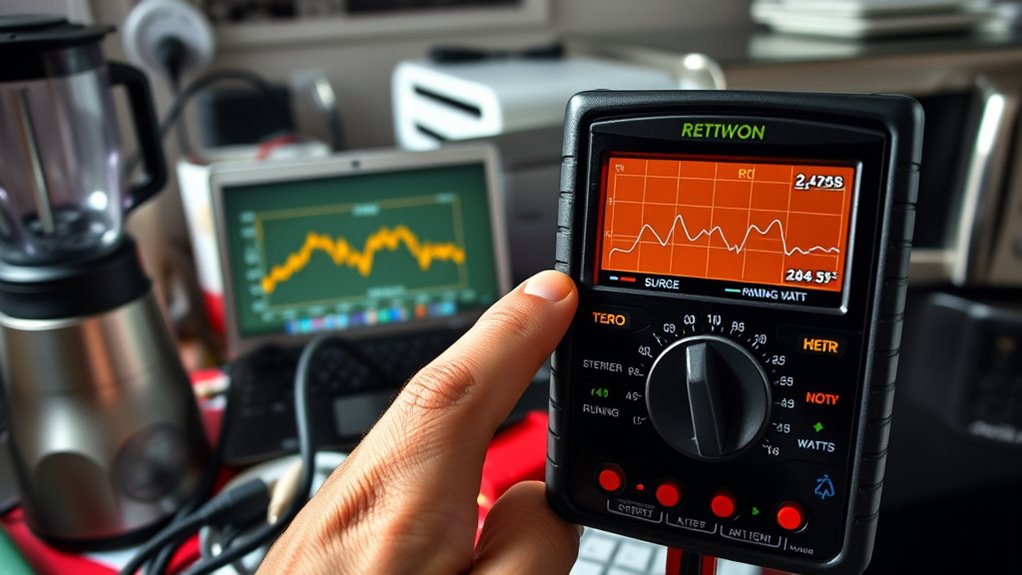
Understanding the difference between surge and running watts is essential when selecting appliances for your power setup. Different appliances have varying surge and running watt needs, affecting efficiency and performance. For example, motors like refrigerators or power tools often require higher surge watts at startup, which can challenge your generator’s capacity. Conversely, appliances like LED lights or chargers consume consistent, lower running watts. Keep in mind that appliance efficiency impacts these numbers—more efficient devices draw less power overall. Additionally, power cord length can influence your setup’s effectiveness; longer cords may cause voltage drops, increasing wattage demands. By comparing surge and running watts across appliances, you ensure your power source can handle both initial startup and continuous operation without overloading. Proper wattage management is key to maintaining a safe and reliable power system.
Tips for Choosing a Generator Based on Watt Ratings

To select the appropriate generator, you need to match its power output to your appliances’ needs. Make sure it can handle both the startup surge and steady running watts for each device. Understanding these ratings guarantees you pick a generator that’s dependable and efficient for your power demands. Additionally, considering paint sprayer specifications can help ensure compatibility with your equipment’s power requirements.
Match Power Needs
Choosing the right generator starts with evaluating your power needs carefully. You want to guarantee it can handle your essential appliances without overloading, which is vital for generator safety. Start by listing everything you plan to run and check their watt ratings. Add these figures to find your total energy requirement. A generator with matching or slightly higher watt ratings will operate efficiently and safely. Avoid choosing a generator with too much excess capacity, as it can lead to unnecessary energy waste. Properly matching power needs promotes energy efficiency and prevents potential damage. Understanding thermal energy transfer is also important, as it can help you comprehend how your generator and appliances manage heat, ensuring safer operation. Remember, understanding your load helps you select a generator that’s both reliable and safe, making your setup more effective and less prone to issues.
Understand Surge Capabilities
Once you’ve calculated your running watt needs, it’s important to contemplate how your generator handles sudden power demands. This is where understanding surge capabilities becomes essential for generator safety. Surge wattage refers to the extra power your generator can produce for a short burst, which is vital when starting appliances with motors or compressors. Always check the wattage accuracy on the generator’s label to ensure it matches your needs. A generator with an adequate surge capacity prevents overloads and protects your devices. Keep in mind that underestimating surge wattage can lead to equipment damage or generator failure. By choosing a generator that clearly states its surge capabilities, you guarantee reliable performance and maintain safety during operation. This knowledge helps you select a unit that’s both efficient and safe for your power needs.
Common Mistakes to Avoid When Selecting a Generator

Many people make the mistake of selecting a generator based solely on its price without considering whether it meets their actual power needs. This often leads to falling for power rating myths, where numbers seem misleading. To avoid this, focus on proper generator sizing rather than just the cost. Here are common mistakes:
- Ignoring surge watt needs and only considering running watts.
- Overestimating or underestimating your power requirements.
- Choosing a generator based on peak power instead of continuous power needs.
- Relying on misleading ratings without understanding the difference between surge and running watts.
- Neglecting to account for the power composition of your appliances and equipment to ensure your generator can handle both surge and steady demands.
Practical Steps to Calculate Your Power Requirements
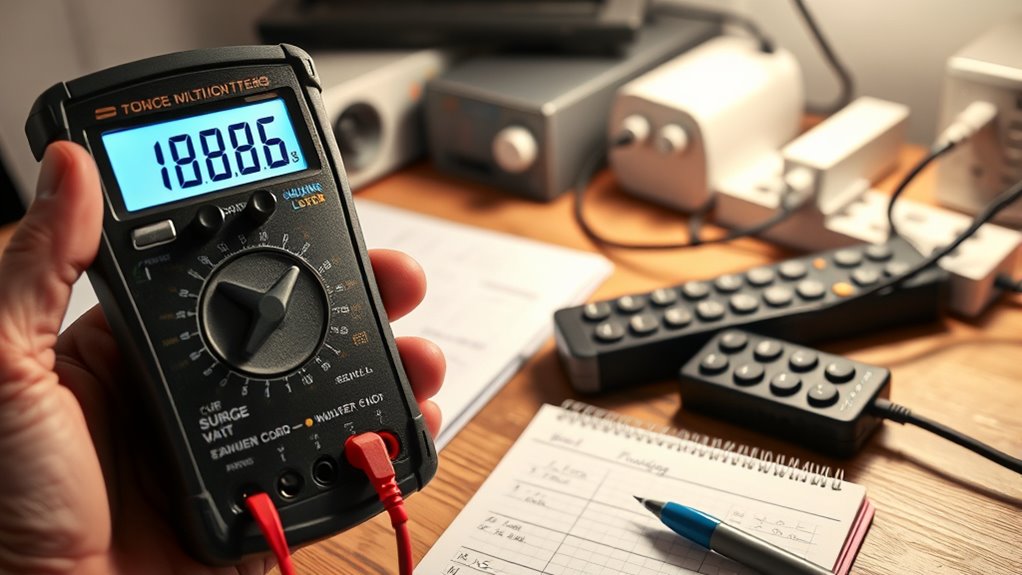
Understanding your actual power needs is the first step toward selecting the right generator. To do this, list all devices you plan to run, noting their surge and running watts. Add these numbers together to find your total power requirement. Consider electrical safety by including a margin for unexpected surges. If you’re interested in renewable energy sources, factor in their startup times and efficiency. Here’s a simple way to visualize your calculations:
| Device | Surge Watts | Running Watts |
|---|---|---|
| Refrigerator | 1200 | 600 |
| Laptop | 300 | 150 |
| Lights | 600 | 600 |
This table helps you ensure your generator can handle your essential appliances safely and efficiently.
Frequently Asked Questions
How Does Altitude Affect Generator Wattage Ratings?
Altitude affects generator wattage ratings because higher elevations require altitude adjustments to maintain power output. As you go higher, the air becomes thinner, which reduces generator efficiency. This means your generator might produce less wattage than rated at sea level. To guarantee reliable performance, you should make altitude adjustments or choose a generator designed for high-altitude use, helping you avoid unexpected power shortfalls and maintain consistent energy supply.
Can Appliances Be Damaged by Incorrect Wattage Selection?
Yes, appliances can be harmed by incorrect wattage selection. When you choose a generator with too little wattage, your appliances may not run properly or could be damaged due to insufficient power. To guarantee appliance compatibility and wattage safety, always match your appliances’ wattage needs with your generator’s capacity, including surge and running watts. Properly rated wattage prevents overloads and keeps your appliances functioning safely and efficiently.
What’s the Difference Between Surge Wattage and Peak Wattage?
A power surge causes a temporary spike in wattage, known as surge wattage, which exceeds the device’s normal running wattage. Peak wattage is the highest wattage a device may draw during startup or under heavy load. Understanding these differences helps you avoid overloading your power source and protect your appliances from damage caused by exceeding their wattage capacity during surges or startup.
Are Inverter Generators Better for Sensitive Electronics?
Yes, inverter generators are better for sensitive electronics because they provide consistent power with minimal fluctuation. They maintain voltage stability, preventing power surges that could damage delicate devices. Unlike conventional generators, inverter models adjust their engine speed to match the load, reducing power fluctuation. This ensures your sensitive electronics, like laptops and medical devices, operate safely and reliably, giving you peace of mind during power outages or outdoor activities.
How Often Should I Perform Maintenance on My Generator?
Think of your generator as a reliable friend who needs regular care. You should follow a maintenance schedule, checking it every 50-100 hours of use. An oil change is key, usually after the first 20-30 hours, then every 100 hours or annually. Regular maintenance keeps it running smoothly, preventing unexpected breakdowns. Stay attentive, and your generator will serve you well when you need it most.
Conclusion
Understanding surge and running watts helps you choose the right generator for your needs. By knowing what each appliance requires, you avoid surprises and guarantee reliable power. Are you ready to confidently power your home or outdoor adventures? Remember, making informed decisions now saves you time and money later. So, take the time to assess your needs carefully—you’ll thank yourself when everything runs smoothly and safely.



